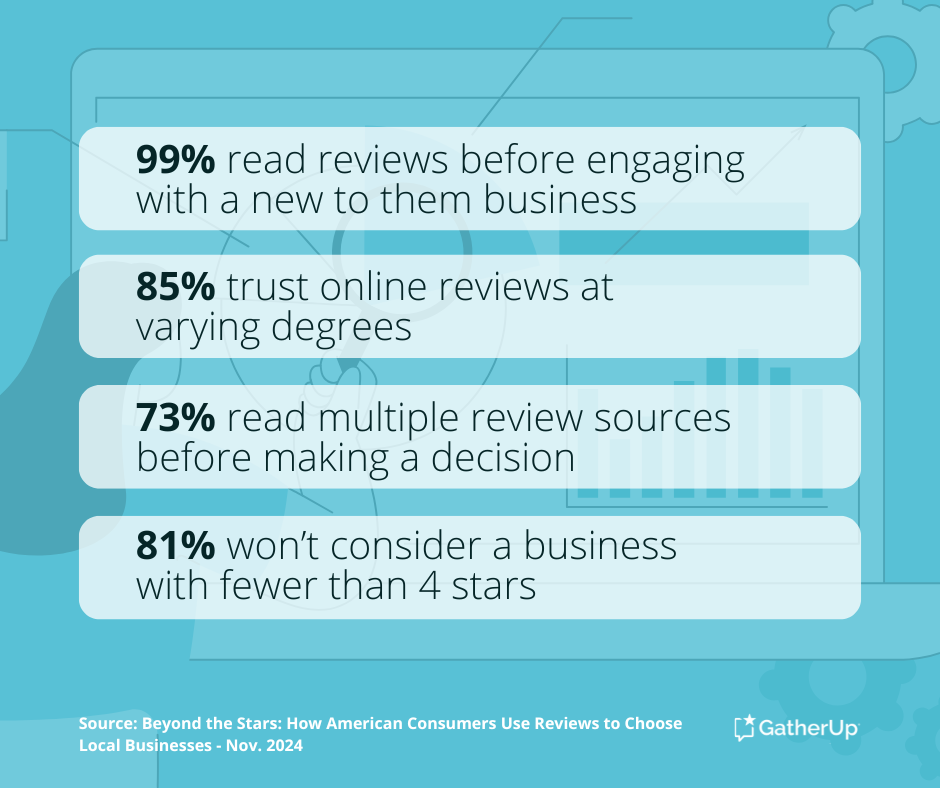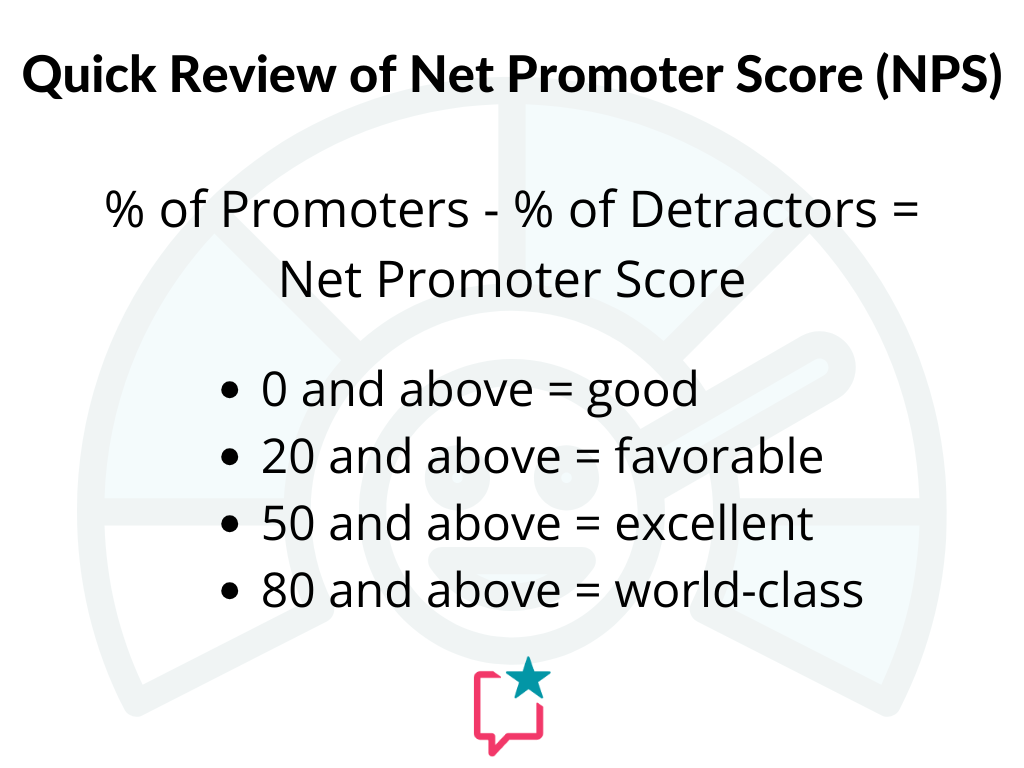2024 Reputation Benchmarks
Online Review Trends Shaping Local Marketing Success
What do potential customers see when they find you online? Are they reading mostly positive reviews or negative reviews? Can they find enough reviews to give them confidence in your products and services? Do they see you responding to reviews, or ignoring them? And what about your star ratings? Taking all these variables into account, the importance of effective online reputation management cannot be overstated.
So, how can your business truly maximize your online reputation?
- Table of Contents
- Do online reviews still matter?
- Ask more, receive more online reviews: the ongoing impact of proactive review generation
- SEO and Public Trust via First and Third-Party Reviews
- Customer Sentiment via Net Promoter Score (NPS)
- Reputation Growth via Star Ratings
- Review Request Methods: Email vs. SMS
- Final Thoughts: What This Means for Proactive Reputation Management in 2025

Do online reviews still matter?
Yes, they still very much matter!
As local businesses continue to compete online for visibility, foot traffic, and profit, their online reputation remains as important as ever.
If your business has an online presence, your reputation has to be a priority. How the public perceives your business — strengths, weaknesses, and overall credibility — can make a huge difference in your ability to attract new customers and drive growth.
In 2023 and again in 2024, we analyzed tens of thousands of businesses across six industries to understand the overall impact of proactive reputation management by looking at review generation trends, ratings and NPS scores, and review request methods.
Here’s a comparison of the 2023 and 2024 data and what it means for your industry and business today.

Ask More, Receive More: The Ongoing Impact of Proactive Review Generation
The more you ask for reviews, the more you receive. When you make review requests a central part of your reputation management strategy, it can have a measurable impact on a host of factors, including review volume, SEO, public trust, customer sentiment, and star ratings.
| Industry | Avg. 1st Party Reviews (2023) | Avg. 1st Party Reviews (2024) | Avg. 3rd Party Reviews (2023) | Avg. 3rd Party Reviews (2024) |
| Healthcare |
443 | 187 | 66 | 43 |
| Insurance |
49 | 150 | 11 | 32 |
| Restaurants |
327 | 162 | 63 | 137 |
| Legal & Law |
21 | 31 | 29 | 32 |
| Storage & Transportation | 140 | 144 | 94 | 60 |
| Construction |
37 | 39 | 29 | 60 |
Review Volume
Proactively requesting reviews — instead of passively waiting for your customers to give you reviews — increases review volume. This principle has remained fairly consistent from 2023 to 2024.
When businesses in the following industries proactively asked for reviews, here were the average number of first-party and third-party reviews they received as a result
Notably, in 2024, the Insurance industry saw big increases year over year in both first- and third-party reviews when they proactively requested them — the highest increase for both review types out of all industries. Restaurants also saw a sizable increase in the number of third-party reviews in 2024 when requesting them.
However, not every industry saw an increase in review volume year over year. Healthcare experienced a decline in first- and third-party reviews from 2023 to 2024. The reason likely has to do with the timing and method of the review request. In healthcare especially, asking for a review in person, at the time of the appointment, is important to introduce the idea to the patient. Then, sending an email or SMS follow-up later prompts the patient to remember the initial request and encourages them to respond. (We’ll talk more about review request methods below).
The opposite is also true: Waiting too long to ask for a first- or third-party review, or only asking via email or SMS without an in-person request as well, may not get you the desired results. Fewer people could end up responding — which can hurt your overall review volume goals and impact other factors like review recency.
66% of consumers like it when they’re asked for a review on the same day as the service.
Source: “How to Respond to Local Business Reviews, Based on Data.” GatherUp. Jan. 16, 2025.
Good to know: One of the main objectives with review generation is to ensure a steady stream of fresh reviews — and the best way to do that is to adopt a multichannel approach toward review requests:
- Ask in person at the time of service, especially if you’re in an industry that requires immediate feedback
- Include review links on signs, receipts, and QR codes — i.e., make it easy and obvious
- Send review reminders by email and SMS
SEO and Public Trust via First and Third-Party Reviews
How findable your business is in search results and how much trust or credibility your business has built with your audience are two of the major factors that influence potential customers. You can improve both SEO and public trust by asking for first-party and third-party reviews.
| First-Party Reviews | Third-Party Reviews |
|
|
Here are some key review-type findings between 2023 and 2024:
- First-party review requests increased in 2024 across most industries, particularly in Storage & Transportation.
- Third-party reviews increased for Insurance and Restaurants in 2024:
- In Insurance, third-party reviews jumped from 11 (2023) to 32 (2024) — a nearly 3X increase.
- In Restaurants, third-party reviews jumped from 63 (2023) to an impressive 137 (2024) — a 2X increase.
- In Healthcare, third-party reviews dropped from 66 (2023) to 43 (2024).
The increase in third-party reviews for Insurance is particularly interesting. People go to extra lengths to read insurance reviews so they can fully understand how their broker or insurer will treat them, their claims, and their coverage. Reviews for considered purchases like insurance really matter — so using proactive reputation management to earn third-party reviews is a great way to properly inform and attract new customers who are doing their due diligence.
For Restaurants, having a large body of third-party reviews really is a make-or-break differentiator. Customers making a dining choice are doing so in the moment — so factors like review volume, recency, and star ratings help them make that decision quickly.
Good to know: Having a mix of first- and third-party reviews ensures that you’re getting all the benefits of both. Focusing exclusively on one or the other is a missed opportunity to ensure your business is not only trusted but visible everywhere it should be — a must in a competitive local market.
Pro tip: Prioritize responding to the detailed, third-party reviews you get. Your public responses to these critical reviews carry a lot of weight and can make a reputational difference with your existing audience and potential customers, especially with regard to NPS (which we’ll cover more below). An added benefit of responding to third-party reviews is that you have to ask less often to get more reviews.
Customer Sentiment via Net Promoter Score (NPS)
When you ask for reviews, you can have a direct influence on customer sentiment. Net Promoter Score (NPS) — how likely your customers are to recommend your business to others — is a reliable measure of customer sentiment that’s been used across industries for years. It’s also an overall predictor of long-term business success, in terms of revenue growth and repeat business.

In 2024, NPS scores increased by at least 5 points from the 2023 scores for all industries we tracked that were using proactive reputation management strategies.
Insurance and Legal & Law earned the highest NPS growth in 2024. Insurance saw a 24-point increase, jumping from 64 in 2023 to 88 in 2024, and Legal & Law saw a 16-point difference, increasing from 69 in 2023 to 85 in 2024.
Again, both of these industries are high-value, considered purchases that are made infrequently but nevertheless have a major impact on people’s lives. For example, if someone is undergoing a divorce, it’s important for them to spend time and energy making sure they hire the right attorney. They need quality, detailed reviews to help them make the right decision. If they choose well, they’re going to have a good experience, which will be reflected down the road in customer sentiment and NPS scores.
Construction still registered an NPS increase in 2024, but it was the lowest point difference, increasing 5 points from 82 in 2023 to 87 in 2024.
|
Industry |
NPS 2023 |
NPS 2024 |
Point Difference |
|
Healthcare |
73 |
87 |
+14 |
|
Insurance |
64 |
88 |
+24 |
|
Restaurants |
66 |
75 |
+9 |
|
Legal & Law |
69 |
85 |
+16 |
|
Storage & Transportation |
54 |
66 |
+12 |
|
Construction |
82 |
87 |
+5 |
|
Industry |
Start of 2024 |
End of 2024 |
|
Beauty & Wellness |
91 |
93 |
|
Automotive Services |
65 |
66 |
|
Funeral Services |
90 |
91 |
|
Financial Services |
88 |
86 |
|
Professional Services |
86 |
85 |
|
Real Estate |
77 |
79 |
|
Cleaning & Maintenance |
79 |
78 |
In 2024, we also tracked the NPS of some additional sectors and found the scores stayed relatively stable within each sector from the beginning to the end of 2024 — indicative again of proactive reputation management.
Good to know: Proactive reputation management continues to correlate with higher NPS. That’s because when you ask for reviews, you’re showing genuine empathy and interest in what the customer has to say — whether positive or negative. It’s also important to understand that NPS is cumulative over time — the result of your ongoing desire to know what your customers really think as well as your ability to use these insights to make your business better.
Pro tip: Regularly ask your customers for feedback using NPS surveys and other customer sentiment check-ins. This creates a robust feedback loop that drives continual business improvement and customer satisfaction. At a minimum, do it twice a year, but it’s even better to do this quarterly.
Reputation Growth via Star Ratings
Star ratings are typically a point-in-time measurement, usually of the last interaction the customer had, and provide a simplified view of how a business is perceived. Review requests continued to positively influence Google star ratings in 2024, as it did in 2023 — though the impact varied by industry.
30% of consumers need close to perfect scores, and only 3% are okay with less than 3 stars.
Source: Beyond the Stars: How American Consumers Use Reviews to Choose Local Businesses, Nov. 2024
As businesses integrate reputation management into their core operations, data reveals that some industries see a narrowing gap in star ratings before and after implementing a proactive request strategy—indicating a plateau.
At this juncture, it's important to focus not just on gathering reviews over time to grow ratings but on actively improving service quality to truly make an impact.
|
Industry |
Stars Before Requests (2023) |
Stars After Requests (2023) |
Stars Before Requests (2024) |
Stars After Requests (2024) |
|
Healthcare |
4.3 |
4.6 |
4.6 |
4.6 |
|
Insurance |
4.4 |
4.4 |
4.5 |
4.5 |
|
Restaurants |
4.2 |
4.2 |
4.2 |
4.3 |
|
Legal & Law |
4.5 |
4.7 |
4.7 |
4.7 |
|
Storage & Transportation |
4.2 |
4.4 |
4.2 |
4.2 |
|
Construction |
4.6 |
4.8 |
4.7 |
4.7 |
Review Request Methods: Email vs. SMS
Just as in 2023, the way in which businesses requested reviews in 2024 mattered a great deal as to whether customers responded or not. Using SMS (texts) and email together continued to yield the highest response rates, but SMS-only strategies lost some ground in 2024 compared to the year prior.
Here’s how the methods stacked up in 2023 vs. 2024 in general (for all industries):
|
Request Method |
Reviews per 100 Requests (2023) |
Reviews per 100 Requests (2024) |
|
SMS only |
20 |
14 |
|
Email only |
15 |
13 |
|
SMS + email |
26 |
29 |
In addition, we wanted to see specifically how each channel performed for each type of review request. The data is convincing that email and SMS together yielded the best results to generate both first- and third-party reviews:
|
Channel |
All per 100 requests |
1st per 100 requests |
3rd per 100 requests |
|
Average |
21 |
16 |
5 |
|
Email only |
13 |
10 |
3 |
|
SMS only |
14 |
11 |
3 |
|
Email + SMS |
29 |
22 |
7 |
Good to know: SMS and email review requests combined can result in a higher lift in star ratings and NPS — no matter the industry. This is likely because both methods reach customers where they are and make it easier for them to respond on their smartphone. This relevance to customers’ busy, on-the-go lives is appreciated and contributes to more positive customer perceptions.
Pro tip: If you haven’t invested in an online review platform that solicits reviews with SMS yet, do so — if for no other reason than to easily reach your customers with reviews requests and bump up your chances that they’ll respond.
Regardless of how they’re prompted, what’s the true motivation for customers to leave a review? It generally comes down to quality of service as 72% of consumers who write reviews do so to reward great service, and 60% do so to warn others of bad service.
But here’s the kicker: How the business responds to reviews — especially the negative ones — can turn a sticky situation into a second chance. Thoughtful, prompt responses don’t just offer empathy and a potential resolution to the reviewer who experienced poor service or a major problem, it also shows potential customers that you pay attention to and care about what your customers think, and are committed to improving.
The difference this can make? Consider that 82% of customers — the vast majority — prefer choosing brands that actively respond to reviews.
Final Thoughts: What This Means for Proactive Reputation Management in 2025
Though there were a few small nuances in the data between 2023 and 2024, the overall advice for businesses engaging in reputation management hasn’t changed much year over year.
Given this, here’s how you can go forward with confidence throughout 2025:
- If you were requesting reviews before, keep it up.
Review requests are a valuable way to form a deeper emotional connection with your customers, which is generally reflected in greater customer satisfaction. Being proactive and consistent with review requests not only can make a measurable impact on review volume, it can also help you maintain a higher NPS and ratings.
- Sending review requests through SMS and email together is still the best strategy, but don’t count out in-person requests.
With these digital methods, you can reach customers in the moment, on their smartphones, where they’re more likely to see and respond to your request. Though sending review requests just through SMS is appealing because of the speed and convenience of it — for you and your customers — it’s also important to make the initial ask in person, if possible, and then follow up with SMS and email. A follow-up request reinforces the first request and can lead to more responses from customers.
- Depending on your industry, you may see either a rise or fall in third-party reviews, so adapt accordingly.
Track your review types by number. If you start getting fewer third-party reviews, make sure to respond to the thoughtful reviews you are getting on third-party sites, as this helps instill public confidence in your business that you’re actively listening to feedback — and this makes your business seem more credible. Others will notice your responses as well and want to leave reviews too.
Need support for your reputation management and review request strategies this year? Schedule a demo with one of our experts.
Be sure to stay tuned for additional, industry-level insights by following us on LinkedIn or our blog. You can also check out our 2023 report for more information.